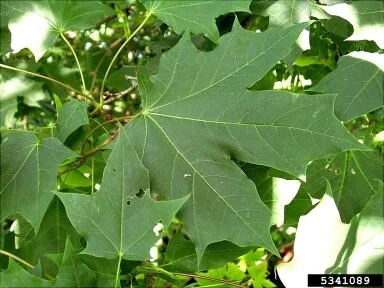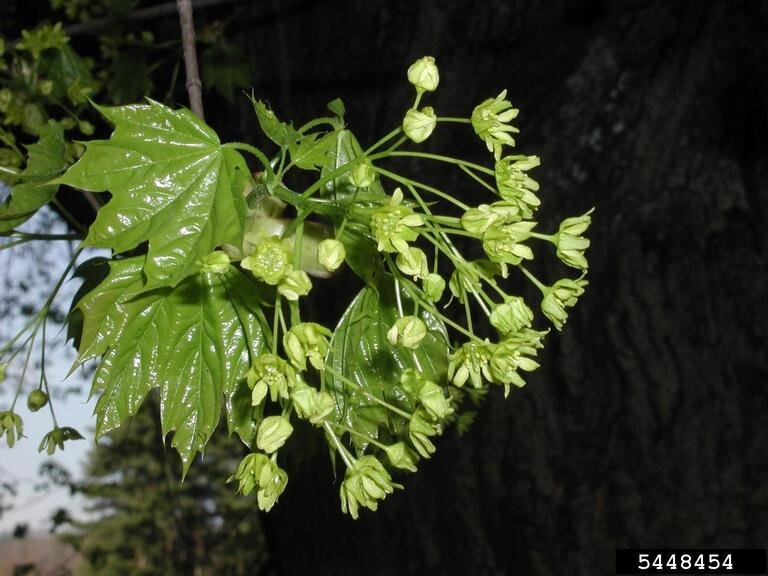June 2021 Invasive Plant of the Month
SICIM Email
Norway Maple (Acer platanoides L.)
Norway maple is a member of the maple family (Aceraceae) from Europe and Western Asia that was introduced as an ornamental shade tree in the 1700s. It has been reported as invasive throughout the northeastern U.S. from Maine to Wisconsin, south to Tennessee and Virginia and also in the Pacific Northwest. It is frequently planted as a street tree and has been seen escaping cultivation in nearby woodlots as well as invading higher quality habitats.
IDENTIFICATION & BIOLOGY: Norway maple is a broad deciduous tree, typically growing 40-60 ft but can reach up to 100 ft. Palmately lobed leaves are opposite and have 5 to 7 sharply acuminate lobes (with large but few teeth). The leaves are 4-7 in. wide and usually green in color, but there are a few cultivated species that are red. The bark of the mature Norway maple has a very regularly ridged pattern similar to white ash, while on younger trees the pattern is more diamond shaped. Norway Maple can be monoecious or dioecious, producing male (staminate) flowers and female (pistillate) flowers on either the same or separate trees. Both types of flowers are produced in umbel-like clusters spanning 2-3" across; each cluster consists of 10-30 flowers. The slender stalks of each corymb are green and either hairless or glandular-hairy. Individual flowers are .25 in wide, appear in April and May, and are yellow-green in color. The pendulous fruit (samaras) are 1.5-2 in long and samara wings are divergent, reaching nearly 180-degree angles to each other. As with other maple species, seeds are dispersed by wind.
LOOK-A-LIKES: Norway maple looks similar to sugar maple (Acer saccharum) and red maple (Acer rubrum), both native species to Indiana. Norway maple can be distinguished by a milky white sap that exudes from the leaf petioles when broken (during spring, summer, and early fall), broad leaves, hair-like leaf tips, and bright yellow fall foliage. The paired samaras of Norway Maple form nearly a 180 degree angle, while those of Sugar Maple are less divergent, forming a 90 degree angle approximately. Norway maples will retain their leaves longer than other maple species in the fall.
HABITAT & DISTRIBUTION: Norway maple prefers full sun and fertile, moist, well-drained soils, but is shade tolerant and occurs in a variety of soil and moisture conditions. It can be found on roadsides, degraded areas, hedgerows, roadside thickets, disturbed and intact forest communities, and is somewhat resistant to drought. It reproduces rapidly with heavy seed crops every 1-3 years.
ECOLOGICAL THREAT: When Norway maple escapes cultivation and invades natural areas it reduces species richness and native tree regeneration by out-competing other trees and understory species for resources, creating dense shade canopies, and spreading rapidly through high seed production. It also releases toxins that reduce the growth and reproduction of native species.
CONTROL:
Prevention: Do not plant Norway Maple. Remove large seed-producing trees and pull, dig, cut, and/or treat with herbicide. Return to remove seedlings and other invasive species that may move in.
Manual: Can be effective for single plants or very small infestations. Hand pull seedlings in spring while soil is moist.
Mechanical: Removal of overstory trees as well as of understory seedlings and saplings is necessary to reduce seed sources. Because Norway maple produces dense stands, removal of all trees may alter site conditions by opening up the site so care must be taken to watch for and remove seedlings from Norway maple as well as other invasives that may move in.
Chemical: Norway maple can be effectively controlled using any of several readily available general use herbicides such as glyphosate or triclopyr. Basal bark treatment is effective for trees less than 4 inches in diameter, using triclopyr at a 20% dilution. Cutting and girdling are effective for trees of any size when cut surfaces are treated with herbicide such as glyphosate. Cut stump method is also effective with glyphosate at a 20% dilution. Foliar application can be effective as well, using glyphosate at a 2% dilution. Because this method involves applying herbicide mix to foliage (leaves), it should be considered for small dense infestations only.
IMPORTANT: The pesticide label is the law! When using any chemical control, always read the entire pesticide label carefully, follow all mixing and application instructions and use all personal protective gear and clothing specified. Contact the Office of Indiana State Chemist (OISC) for additional pesticide use requirements, restrictions or recommendations.
Maintenance: Follow-up treatments will be required, as seeds already present in the soil will sprout.
REFERENCES & OTHER RESOURCES:
http://bugwoodcloud.org/resource/pdf/FHTET-2017-05_New%20Invaders_SE.pdf
https://www.illinoiswildflowers.info/trees/plants/norway_maple.htm
https://www.invasive.org/alien/pubs/midatlantic/control-trees.htm
https://www.invasive.org/gist/products/handbook/methods-handbook.pdf
https://www.misin.msu.edu/facts/detail/?project=misin&id=3&cname=Norway+maple
LOOK-A-LIKE REFERENCES:
http://www.illinoiswildflowers.info/trees/plants/sugar_maple.html
http://www.illinoiswildflowers.info/trees/plants/red_maple.html
#NorwayMaple #Acerplatanoides #IndianaInvasiveSpecies #IndianaInvasivesInitiative









